Nutritional considerations for the aging cat
Written by Vincent Biourge and Denise Elliott
Improved veterinary care, nutrition and lifestyle have collectively improved the life expectancy of dogs and cats over the last 20 years. Nutrition and appropriate nutritional management have been shown to alleviate, postpone, slow down and even prevent diseases commonly associated to the process of aging, allowing a better quality of life in older pets.
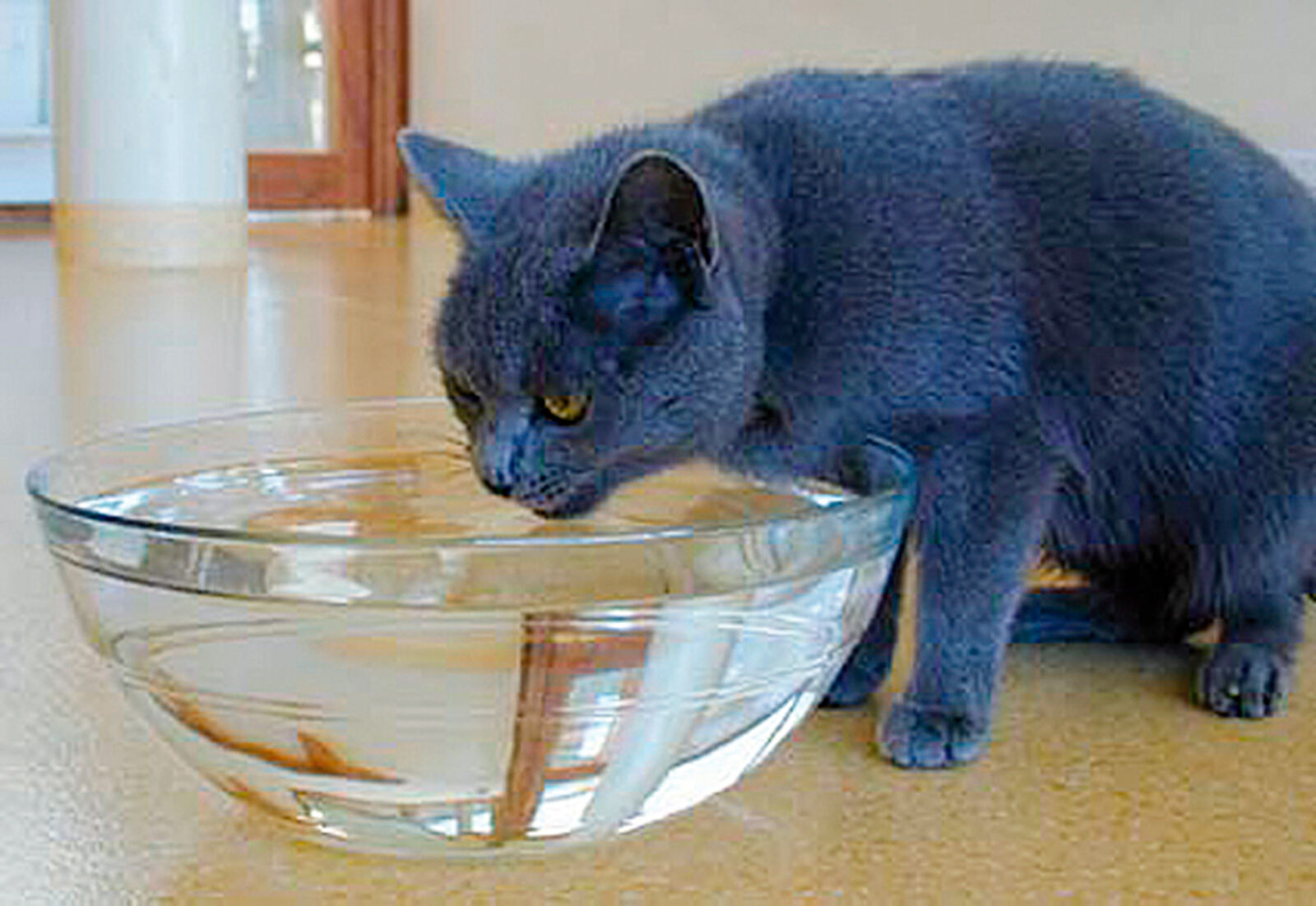
Key points
The nutritional recommendations for older healthy cats must take into account the specific requirements of the feline species and the impact of aging on physiology and metabolism, as well as dietary strategies that could help to prevent or slow down disease processes.
Longevity requires a healthy start from an early age; nutrient deficiencies as well as excesses will significantly affect lifespan.
Knowing some of the main “social rules” that help persuade people to do something can make it easier for the clinician to convince an owner that instructions should be implemented.
It is important to maintain optimal body condition for a cat’s entire life. Veterinary practitioners should thus assess the diets and dietary management of the aging pet and make recommendations based on the latest scientific knowledge.
Introduction
Improved veterinary care, nutrition and lifestyle have collectively improved the life expectancy of dogs and cats over the last 20 years[1][2]. Nutrition and appropriate nutritional management have been shown to alleviate, postpone, slow down and even prevent diseases commonly associated to the process of aging, allowing a better quality of life in older pets [3][4][5][6]. Veterinary practitioners should thus assess the diets and dietary management of the aging pet and make recommendations based on the latest scientific knowledge.
Many age-related feline diseases (e.g., chronic kidney disease, osteoarthritis, diabetes mellitus, hyperthyroidism) are more frequently observed after ten years of age, and with most of these diseases (and especially in cats) obvious clinical signs occur rather late in the pathophysiological process. Diets for “healthy” senior cats should therefore integrate aspects that will help prevent diseases associated with aging in their formulation. Cats tend to live longer than dogs and it is not uncommon for veterinarians to see cats that are more than 15 years of age. However, as with humans, the genetic and environmental background of each animal means that the chronological and physiological ages do not always match. The nutritional recommendations for the older healthy cat must therefore take into account the specific requirements of the feline species and the impact of aging on physiology and metabolism, and include dietary strategies that could help prevent or slow down disease processes commonly associated with aging (Table 1)[1][7].
|
|
|
|
Although this paper will focus on the nutritional needs of the healthy aging cat, longevity requires a healthy start from an early age. Both nutritional deficiencies and excesses will significantly affect lifespan, and it is important to maintain optimal body condition in cats for their entire life [9][10]. This might be a challenge, especially following neutering, but feeding diets formulated for neutered cats (e.g., less energy-dense) and adjusting the ration for the body condition have clearly been shown to contribute to achieving life-long optimal body condition (Figure 1)[11].
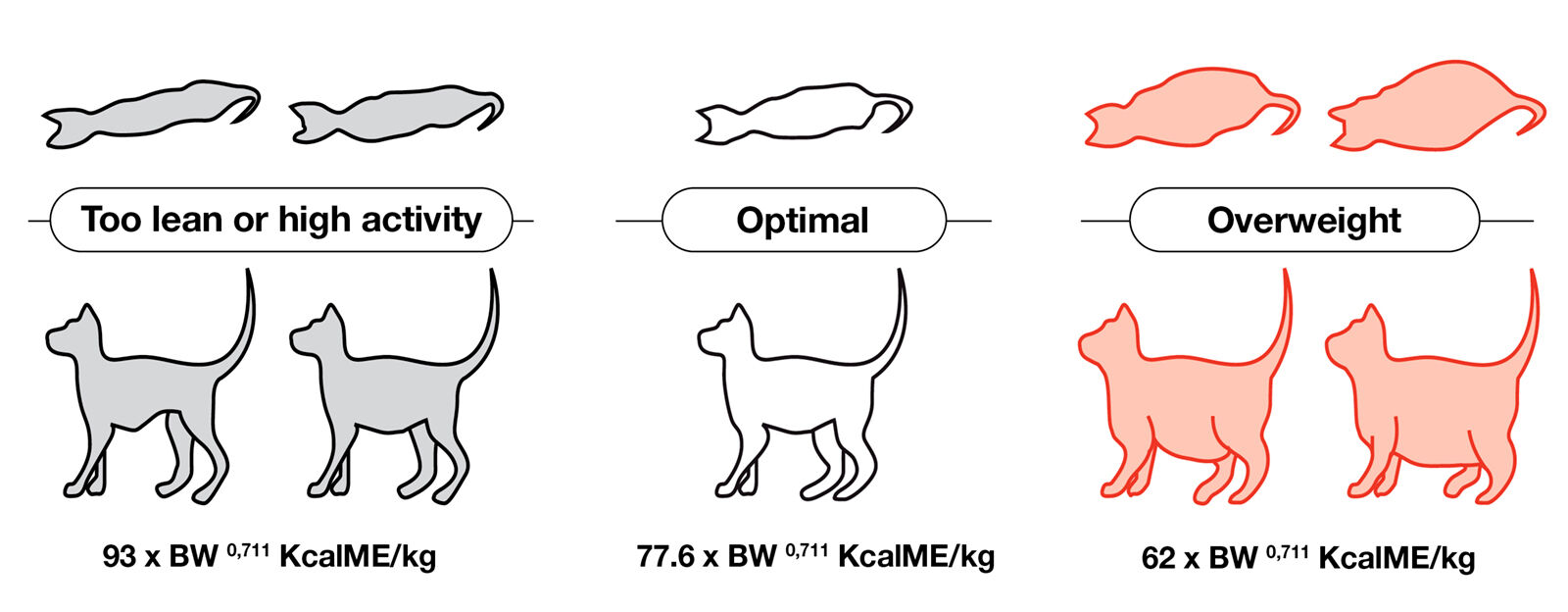
The most precisely formulated diet will only help an aged cat if it is willing to eat it. Special care should thus be taken to ensure maximum palatability by a combination of quality ingredients, and careful selection of aroma, kibble size and the texture of the diet. Note that older cats are at increased risk of suffering from diseases that cause polyuria/polydipsia and are more likely to suffer from lameness, and it is therefore essential to provide them with easy access to fresh water (Figure 2).

Consequences of aging on dietary requirements
Energy
As with other species, aging in cats is associated with a decrease in lean body mass and an increase in fat mass[1][12]. Since lean mass is the metabolically active tissue, energy expenditure and energy needs should thus decrease with age, but this is not true in all cats, especially those above 12 years of age. There is evidence that as many as one-third of older cats have a decreased ability to digest food, especially fat and protein [1]. This is supported by a lower prevalence of obesity in cats above 10 years of age (Figure 3) [9][13]. Therefore not all senior diets should have reduced energy content; energy density and calorie allowance should be adjusted to maintain optimal body condition. As a starting point recommendations are available (Figure 1)[7][9] as follows;
- Adult cat (moderate activity – all cats, whether neutered or entire) = 77,6 x BW 0,711 KcalME/kg
- Adult intact cat and mature cat (high activity) = 93 x BW 0,711 KcalME/kg
- Overweight cat = 62 x BW 0,711 KcalME/kg
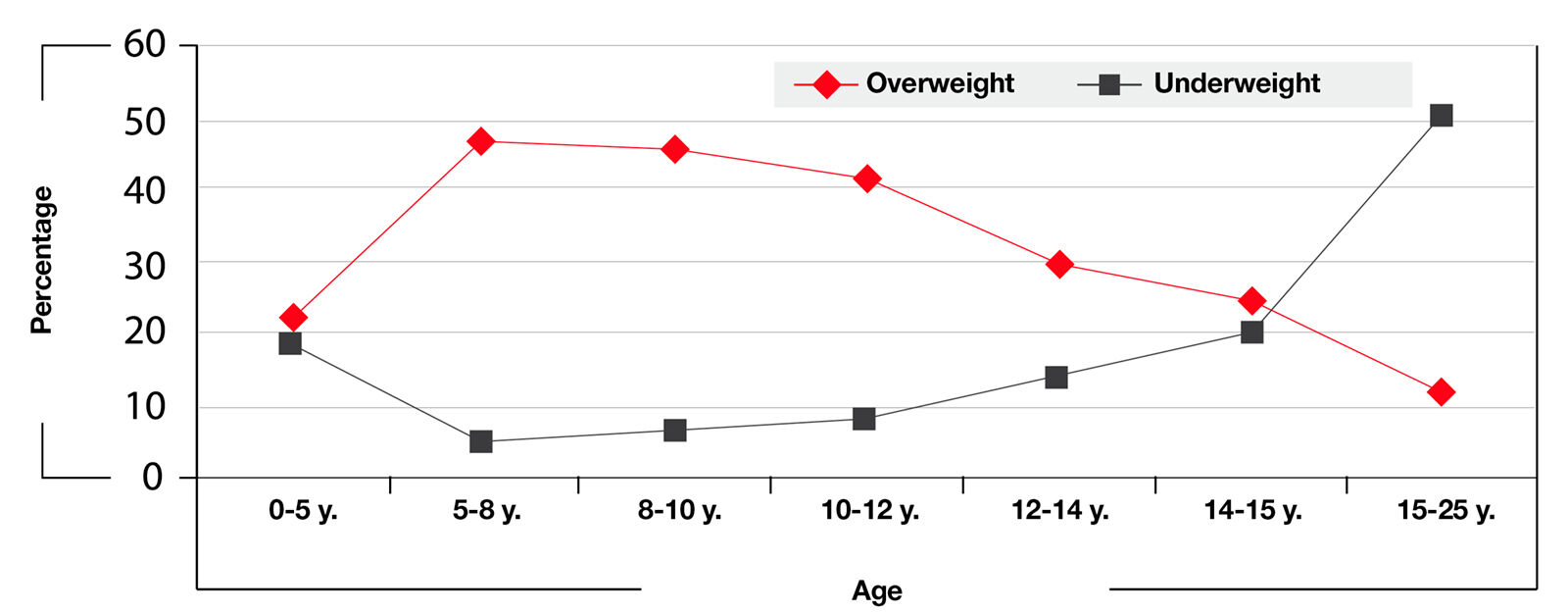
As individual and seasonal variability can be high in cats, calorie allowance should then be adapted to the body condition of each patient. Life expectancy is lower in cats that are below or above optimal body condition[10]. Poor body condition can be an early indicator of a clinical problem that will not allow compensating episodes of fasting commonly associated with disease. As well as promoting lameness and encouraging skin problems (because the cat does not groom) obesity promotes insulin resistance (Figure 4) [9] and consequently diabetes mellitus is a frequent complication of feline obesity. There are some controversies regarding the use of carbohydrates as an energy source in feline diets; cats have evolved as true carnivores and as such, when compared to dogs or humans, have a lower ability to digest and metabolize carbohydrates[14][15]. However, cats are very good at using large amounts of well-cooked carbohydrates in their diet and obesity, rather than high carbohydrate consumption per se, promotes insulin resistance[14][15][16][17]. In cats that are overweight and/or have diabetes mellitus, reduction of dietary carbohydrates, reduction of energy intake and increased dietary protein can collectively improve both the body condition and rate of remission, and allow reduction in the insulin dose[17].
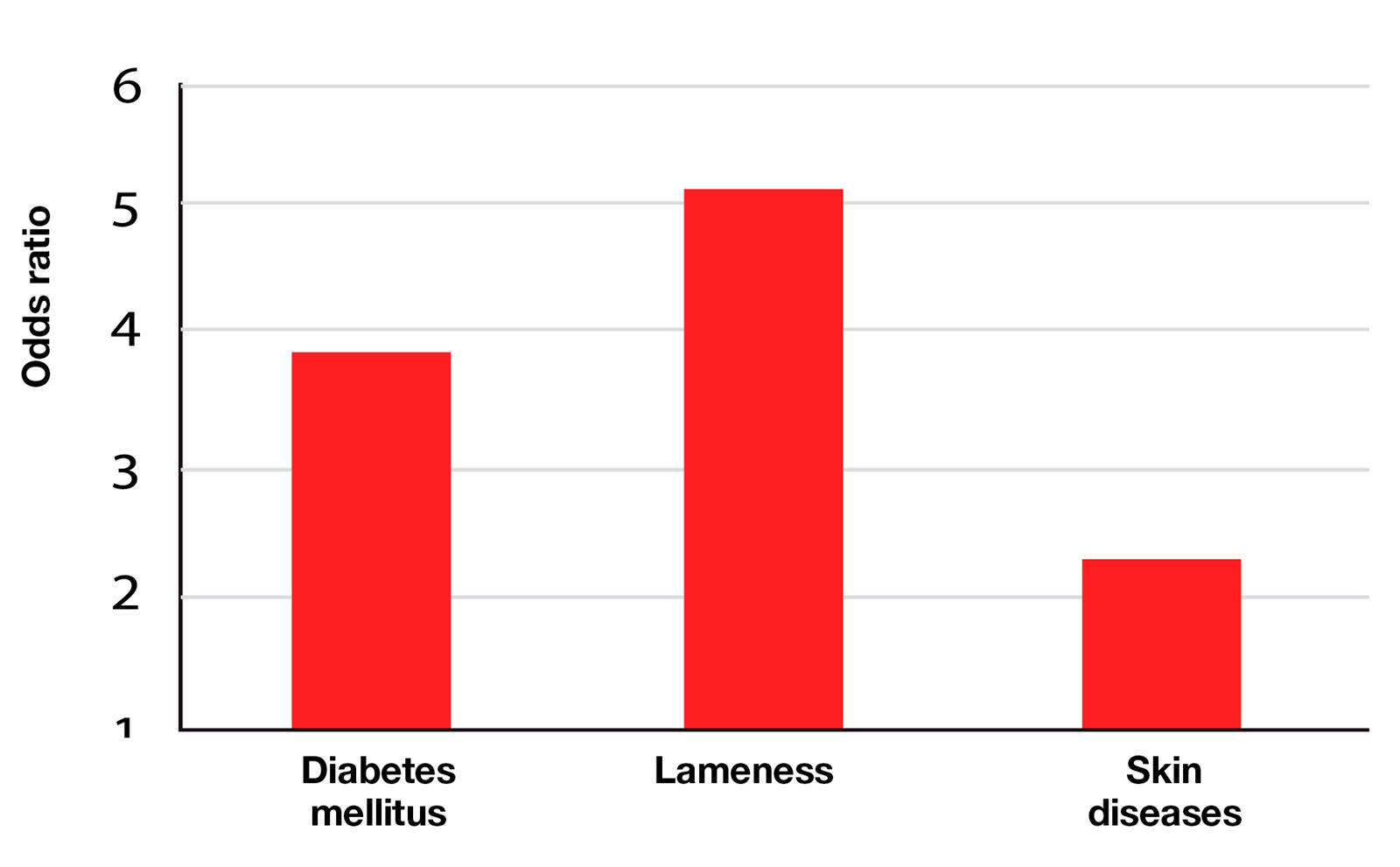
In addition to being an energy source, fats also provide essential fatty acids [7]. There are two families of essential fatty acids, omega-6 (vegetable oil) and omega-3 (soybean, flaxseed and fish oils) and it is important to balance them. Early signs of essential fatty acid deficiencies are a dry, unkempt, dull hair coat. There is good evidence in other species (and some suggestions in cats) that long-chain omega-3 fatty acids (EPA and DHA) from fish oil contribute to a healthy immune system and cognitive function (e.g., learning, memory); they may also reduce inflammatory processes (such as those observed in osteoarthritis and dermatitis), slow the progression of renal disease, and could be beneficial in preventing diabetes mellitus and cancer [6][15][18].
Shorter-chain omega-3 fatty acids (α-linolenic acid) such as found in flaxseed oil, cannot be converted to EPA and DHA in cats (and there is a very poor conversion efficiency in dogs) [7]. Gamma-linolenic acid (borage oil, primrose oil), although an omega-6 fatty acid, will also have anti-inflammatory benefits through the prostaglandin-1 pathway.
Protein
In the past, it has been commonly recommended to restrict protein in older cats based on the (false) belief that this would help to protect kidney function. However research shows that protein restriction is unnecessary in older cats, even with early renal disease [18][19], and restriction in dietary phosphorus and supplementation with EPA/DHA have been shown to be the most important factors in slowing the progression of renal disease [18]. In dogs, protein requirements have been found to increase with age [1]; similar data are missing in cats but because of their true carnivorous nature, dietary protein requirements are much higher in cats of all ages [7]. Protein quality must also be taken into account. Poor protein digestibility will promote proteolytic colonic flora (the so-called “bad” flora, Clostridium perfringens etc.), softer feces and fecal odor. Contrary to common belief, some vegetable proteins, such as wheat gluten, corn gluten, soy protein isolate and hydrolysate, are very digestible, and their amino-acid composition is easily balanced by careful choice of ingredients; they are also low in phosphorus, and are therefore the proteins of choice in diets for senior cats.
Dietary fiber
Dietary fibers are essential for the health of the gastrointestinal tract [7].
They contribute to the regulation of transit, although excessive
amounts (> 25%) of insoluble (non-fermentable) fibers may promote
constipation in the aged cat. Dietary fibers will contribute to satiety
and reduce energy intake in those cats that tend to be overweight (Figure 5) [20].
Fermentable fibers, also called prebiotics, such as beet pulp, chicory
pulp, and fructo-oligosaccharides promote a healthy flora and the
production of short-chain fatty acids, especially butyrate, an important
energy source for the colonocytes. A recent study indicated that a
combination of prebiotic fiber, linoleic acid, EPA/DHA and antioxidants
could promote longevity in aging cats by better preserving their body
weight, lean body mass, red blood cell count and skin thickness [6].
Note that the level of dietary fiber will vary considerably depending
on the target energy density of the diet (15-90 g/1000 Kcal ME).
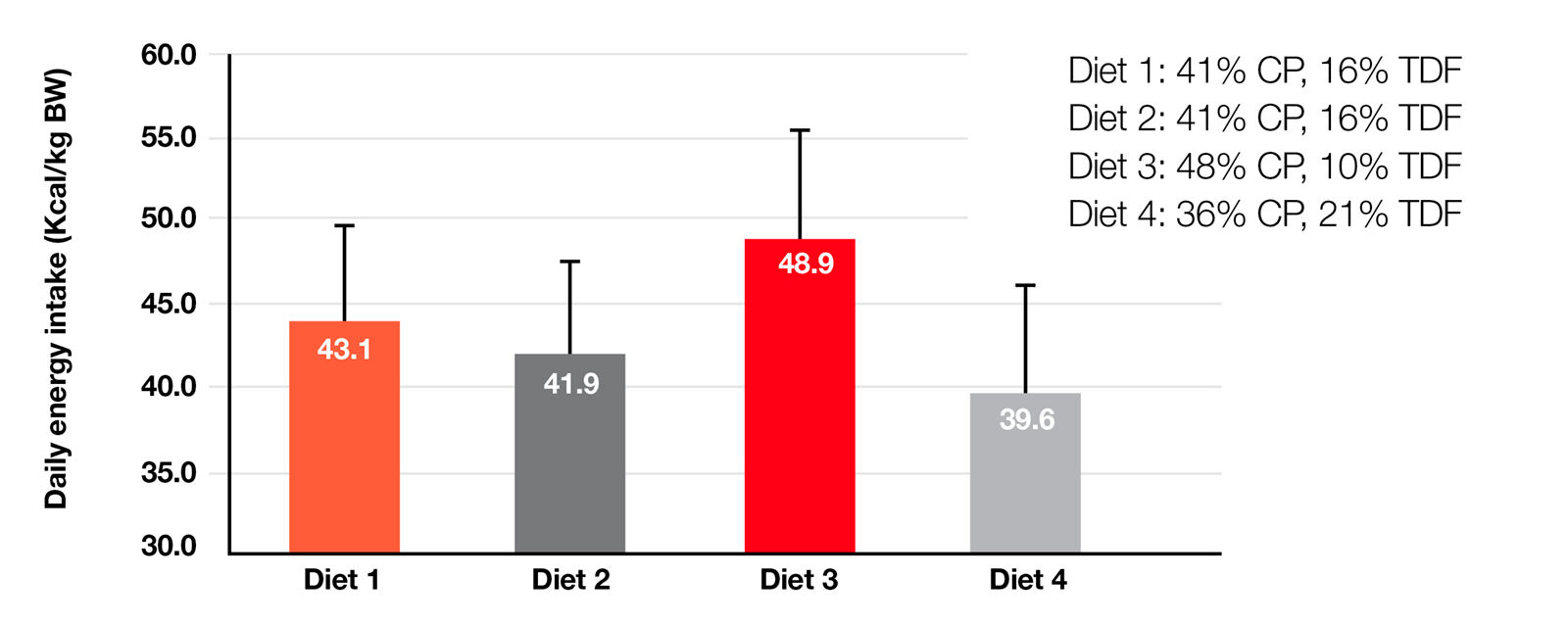
Minerals
As phosphorus restriction has been shown to slow the progression of renal disease, and the prevalence of renal disease is very high in older cats, it is often recommended to reduce the level of phosphorus to the minimum recommended levels (1.25-2.0 g/1000 Kcal) in diets for senior cats [1] [18]. The calcium/phosphorus ratio should be balanced accordingly. It has been suggested that levels of dietary sodium (2.5-3.0 g Na/1000 Kcal) that stimulate diuresis will promote the progression of renal disease [21]but literature published in peer-reviewed journals does not support this claim; of five scientific papers looking at the association between sodium intake and progression of renal disease in cats and dogs, four failed to find any association [21][22][23][24][25]and the claim that foods high in NaCl are associated with a progressive decline in renal function [26]has been disputed. Hypokalemia is common in older cats, especially in those with renal disease, and dietary levels of potassium should therefore not be too near the minimum recommendations, especially if the diet is acidifying. Calcium oxalate (CaOx) stones are more common in older cats, but the pathophysiology of CaOx is still poorly understood [27]. Urinary pH is a poor predictor of CaOx urine saturation [27][28], but promoting urine dilution by feeding moist food and/or increasing dietary sodium (2.5-3.0 g/1000 Kcal) is an efficient way to reduce CaOx saturation [27].
Vitamins
Oxidative damage plays an important role in many diseases associated with aging such as arthritis, cancers, cardiovascular and neurological diseases. Considerable evidence in humans and animals suggest antioxidants may offer some protection against oxidative stress and normal aging processes [1] [6]. Studies on antioxidants in cats have reported beneficial effects on markers of oxidative status [29]and it is thus reasonable to recommend increased amounts of antioxidant nutrients. Supplementation with a combination of antioxidants (e.g., Vitamins C and E, taurine, lutein, polyphenols) is preferred, as they act in different areas of the cell and have a synergistic action. As they are necessary for the synthesis of key enzymes and substrates in the antioxidant pathways, it would seem prudent to provide adequate protein and trace-element intakes in diets for aged cats.
Other nutrients
Several non-essential nutrients have been recommended in the diets of aged cats, for example L-carnitine for its role in fat oxidation. Osteoarthritis is very common in older cats, but the clinical signs are poorly recognized by owners [30], and whilst the owner may not seek veterinary advice, dietary supplementation may well be beneficial for the cat – a recent double-blind randomized clinical study showed the efficacy of a combination of green-lipped mussel, glucosamine, chondroitin sulphate plus EPA/DHA on the perceived and objective activity of cats with osteoarthritis [31].
The nutritional recommendations of the aged healthy cat must therefore take into account the specific requirements of the feline species, to promote maintenance of an optimal body condition and adjust and/or provide nutrients as necessary that will help prevent or slow down the progression of diseases associated with aging.
References
- Laflamme DP. Nutrition for aging cats and dogs and the importance of body condition. Vet Clin North Am Small Anim Pract 2005;35:713-742.
- Kraft W, Danckert D. Development of the age structure of a cat population compared with the dog. Tierarztl Prax Ausg K Klientiere Heimtiere 1997;25:678-683.
- Elliott J, Rawlings JM, Markwell PJ, et al. Survival of cats with naturally occurring chronic renal failure: effect of dietary management. J Small Anim Pract 2000;41:235-242.
- Smith GK, Paster ER, Powers MY, et al. Lifelong diet restriction and radiographic evidence of osteoarthritis of the hip joint in dogs. J Am Vet Med Assoc 2006;229:690-693.
- Appleton DJ, Rand JS, Sunvold GD. Insulin sensitivity decreases with obesity 0and lean cats with low insulin sensitivity are at greater risk of glucose intolerance with weight gain. J Feline Med Surg 2001;3:211-228.
- Cupp CJ, Kerr WW, Jean-Philippe C, et al. The role of nutritional interventions in the longevity and maintenance of long-term health in aging cats. Intern J Appl Res Vet Med 2008;6:69-81.
- National Research Council. Nutrient requirements of dogs and cats. The National Academies Press, Washington, DC. 2006;1-373.
- Bermingham EN, Thomas DG, Morris PJ, et al. Energy requirements of adult cats. Br J Nutr 2010;103:1083-1093.
- Scarlett JM, Donoghue S. Overweight cats: prevalence and risk factors. Int J Obesity 1994;18:22-28.
- Scarlett JM, Donoghue S. Associations between body condition and disease in cats. J Am Vet Med Assoc 1998;212:1725-1731.
- Nguyen PG, Dumon HJ, Siliart B, et al. Effect of dietary fat and energy on body weight and composition after gonadectomy in cats. Am J Vet Res 2004;65:1708-1713.
- Taylor EJ, Adams C, Neville R. Some nutritional aspects of ageing in dogs and cats. Proc Nutr Soc 1995;54:645-656.
- Lund EM, Armstrong PJ, Kirk CA, et al. Health status and population characteristics of dogs and cats examined at private veterinary practices in the United States. J Am Vet Med Assoc 1999;214:1336-1341.
- Backus RB. Controversy over carbohydrates in diets for cats. In Proceedings, ACVIM Forum, Montreal, 2009;12-14.
- Lutz TA, Feline diabetes mellitus: dietary strategies. In: Pibot P, Biourge V, Elliott D (eds.) Encyclopedia of Feline Clinical Nutrition. Royal Canin, Aimargues, France. 2008;183-212.
- Slingerland LI, Fazilova VV, Plantinga EA, et al. Indoor confinement and physical inactivity rather than the proportion of dry food are risk factors in the development of feline type 2 diabetes mellitus. Vet J 2009;179:247-253.
- Slingerland LI, Robben JH, van Haeften TW, et al. Insulin sensitivity and beta-cell function in healthy cats: assessment with the use of the hyperglycemic glucose clamp. Horm Metab Res 2007;39:341-346.
- Elliott DA. Nutritional management of chronic renal disease in dogs and cats. Vet Clin North Am Small Anim Pract 2006;36:1377-1384.
- Finco DR, Brown SA, Brown CA, et al. Protein and calorie effects on progression of induced chronic renal failure in cats. Am J Vet Res 1998;59: 575-582.
- Servet E, Soulard Y, Venet C, et al. Evaluation of diets for their ability to generate satiety in cats. J Vet Intern Med 2008;22:808 (abst).
- Kirk CA, Jewell DE, Lowry SR. Effects of sodium chloride on selected parameters in cats. Vet Ther 2006;4:333-346.
- Greco DS, Lees GE, Dzendzel G, et al. Effect of dietary sodium intake on glomerular filtration rate in partially nephrectomized dogs. Am J Vet Res 1994;55:152-159.
- Buranakarl C, Mathur S, Brown SA. Effects of dietary sodium chloride intake on renal function and blood pressure in cats with normal and reduced renal function. Am J Vet Res 2004;65:620-627.
- Hughes KL, Slater MR, Geller S, et al. Diet and lifestyle variables as risk factors for chronic renal failure in pet cats. Prev Vet Med 2002;55:1-15.
- Xu H, Laflamme DPL, Long GL. Effects of dietary sodium chloride on health parameters in mature cats. J Feline Med Surg 2009;11:435-441.
- Elliott J, Lefebvre H. Letter to the editor of Vet Therapeutics. 2007.
- Biourge V. Sodium, urine dilution and lower urinary tract disease. In Proceedings, ACVIM forum. Louisville, KY. 2006;17-19.
- Van Hoek I, Tournier C, Garnier F, et al. Acidic urine does not promote urinary calcium oxalate supersaturation in healthy cats. In Proceedings ECVIM-CA congress, Porto. 2009; 83 (abst).
- Zicker SC, Wedekind KJ, Jewell DE. Antioxidants in veterinary nutrition. Vet Clin Small Anim 2006;36;1183-1198.
- Hardie EM, Roe SC, Martin FR. Radiographic evidence of degenerative joint disease in geriatric cats: 100 cases (1994-1997). J Am Vet Med Assoc 2002;220: 628-632.
- Lascelles BDX, DePuy V, Thomson A, et al. Evaluation of a therapeutic diet for feline degenerative joint disease. J Vet Intern Med 2010;42;487-495.
Vincent Biourge
DVM, PhD, Dip. ACVN, Dip. ECVCNFrance
Dr. Biourge graduated from the Faculty of Veterinary Medicine of the University of Liège, Belgium, in 1985. He remained as an assistant in the Department of Nutrition for two years before moving to the Veterinary Hospital at the University of Pennsylvania, Philadelphia, and later to the Veterinary Medical Teaching Hospital at the University of California, Davis (UCD) as a PhD/resident in Clinical Nutrition. He received his PhD in Nutrition from UCD in 1993 and also attained his ACVN certificate. In 1994 he joined Royal Canin’s Research Center in Aimargues as Head of Scientific Communication and Nutritionist, and managed the nutritional research program between 1999-2007. In 2008 he became the Center’s Health & Nutrition Scientific Director.
Denise Elliott
BVSc (Hons), PhD, Dip. ACVIM, Dip. ACVN
United Kingdom
Dr. Elliott received her degree in Veterinary Medicine from the University of Melbourne in 1991. After completing an internship in Small Animal Medicine and Surgery at the University of Pennsylvania, she completed a residency in Small Animal Internal Medicine and Clinical Nutrition at UCD. Denise Elliott became a ACVIM diplomate in 1996 and an ACVN diplomate in 2001, the same year in which she received her PhD in Nutrition from UCD for her work on multifrequency bioelectrical impedance analysis in healthy cats and dogs. She is currently Head of Research at the WALTHAM Centre for Pet Nutrition.
Other articles in this issue
Share on social media